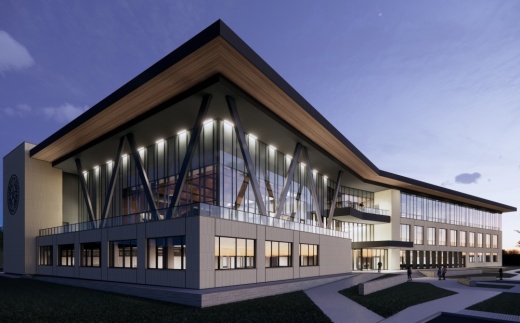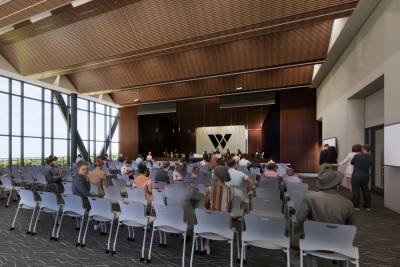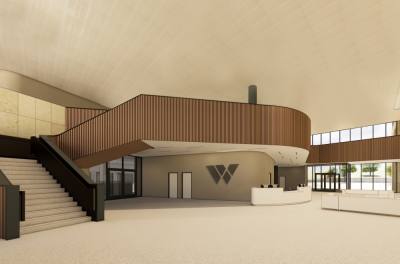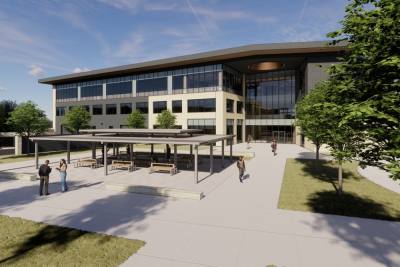The $90 million, 120,000-square-foot building will house 12 departments, including five operating in the Williamson County Courthouse.
In preparation of the WCAB, officials are discussing the historic courthouse’s future while maximizing space downtown.
Current situation
Over the next five years, Williamson County could relocate up to 16 departments and open four new facilities. The county has 63 departments and 1,921 employees as of February, according to county documents.
County Manager Rebecca Clemons compared the relocations to falling dominoes, and said the first domino is pulling staff from the courthouse, justice center and tax office to the WCAB.
“We’ll have several areas that will get a little bit of space pressure alleviated,” Clemons said.
Departments that will remain in the downtown facilities will be able to spread out, Clemons said.
While staff is still examining long term relocation options for employees in the courthouse, justice center and tax office, Clemons said officials are eyeing downtown space along with:
- The Lake Creek Annex
- A soon-to-be expanded Juvenile Justice Center
- A proposed new Jail and Justice Center complex
Departments or offices relocating to the WCAB include the:
- County Commissioners Courtroom
- County judge’s Office
- County tax assessor/collector's Georgetown office
- County clerk’s records division
- County treasurer
- County auditor
- County manager
- Budget office
- Legal department
- Purchasing department
- Community Development Block Grants
- Public affairs office

The context
The county has 17 properties, 12 buildings and one parking garage in downtown Georgetown, including the Jail and Justice Center complex, according to county documents. However, there are limits to expanding downtown.
“The justice center is out of space, and we’re squeezing people in all different little nooks and crannies,” Covey said. “Can we build something by 2030? I think the answer is yes.”
Commissioners voted to eventually move the Jail and Justice Center functions out of downtown, but exactly when and where a new complex would be opened remains undecided, Covey said. She said it would remain in Georgetown and hopes it could serve the county through 2050.
Depending on the market, a new complex could be anywhere from $600 million-$800 million, Clemons said. The county’s 2030 relocation goal is “aggressive,” and officials hope to choose a firm this summer, Clemons said.
“2025—I see it as a planning year,” Covey said. “We’re making a decision that will impact future courts for generations, and we want to lay it out in a very well-thought-out plan.”
If approved by the Texas Legislature, the county could also add a seventh district court as early as October, according to previous reporting.
While the downtown location doesn’t have room for a new courtroom, the Juvenile Justice Center will create a new full-time courtroom once it’s expanded, Covey said.

Breaking it down
As departments in the Williamson County Jail, county tax office and justice center relocate next year, Georgetown Downtown & Tourism Director Kim McAuliffe said officials identified the properties as sites to potentially repurpose in the future.
“It would be transformative to downtown to see those redevelop into a different type of use,” McAuliffe said. “We, of course, have valued the government center being here and having a lot of the employees and folks visiting the county for various services come into downtown. I think it gives us a lot of new opportunities.”
McAuliffe said properties on the square are consistently in the highest demand. “When we receive interest requests to come into downtown, most of the time...they are talking about the square,” McAuliffe said.
From 2019-24, the combined market value of properties in the downtown overlay district grew by $135.3 million, according to an email from the Williamson Central Appraisal District.
In 2024, Williamson County’s total market value reached $171.77 billion according to previous Community Impact reporting.
Market value is based on sales in the area and is reflective of what buyers would purchase the properties for each year as of Jan. 1, an official with the Williamson Central Appraisal District said.
Who it affects
In December, county commissioners agreed to vacate the Williamson County Courthouse once the WCAB opens.
“We outgrew the historic courthouse years ago,” Covey said. “Yet, I want that building to remain a county asset. I do believe it is the jewel of the county.”
Commissioners are considering relocating The Williamson Museum or the Georgetown Visitors Center—which are already located on the downtown square—into the historic courthouse, she said.

As neither of the organizations are in taxable space, their relocations—which could happen as early as 2026—would allow the buildings to be put back on the county tax roll, Covey said.
“There are certainly some potential advantages of having the visitors center located in the courthouse along with the museum,” McAuliffe said.
Covey said she’s working alongside the city and museum to bring proposals to Commissioners Court in the near future, as relocating the two operations to the courthouse requires an official vote.
“It’s a wonderful building. It’s got a lot of stories to tell,” Covey said.
As the county begins relocating, downtown Georgetown could initially look “quite a bit different,” McAuliffe said. The tax office regularly gets customers on weekdays, and Tuesday Commissioners Court meetings attract a large number of people to the square, she said.
“They may have stopped by ThunderCloud to pick up a sub or stopped and got some coffee while they were down here, and they won’t be doing that anymore,” McAuliffe said. “But just because those things aren’t happening, it doesn’t mean that I think the demand won’t come back.”
If the county does decide to vacate from downtown entirely, McAuliffe said it would be a trade-off. While the county’s exit could cause a temporary dip in downtown activity, the city and county could work together to attract a user that would bring an employee base back to the area, she said.
Duncan Isenhower, retail manager at Six Strings Guitar & Lounge on the square, said by talking to regulars and out-of-town visitors visiting the shop, he doesn’t anticipate the county relocations affecting business.
“I have found, from standing behind this register for the past two years, how destination it is down here for people, regardless of work,” Isenhower said.
The takeaway
Covey said the county is hiring a program manager to help coordinate the county’s interim facilities plan and manage relocations.
The county is considering eventually opening its first medical examiner’s office at the Lake Creek Annex, Clemons said.
The WCAB will be the 10th county department located on a roughly 2-mile strip of the SE Inner Loop, including:
- Emergency Medical Services
- Emergency Services Operations Center
- The Facilities department
- Fleet Services
- The Georgetown Annex
- The Juvenile Detention Center
- The Regional Animal Shelter
- The Road & Bridge department
- Wireless Communications
“As more moves there, I think you're going to see more development in that area,” Covey said.








